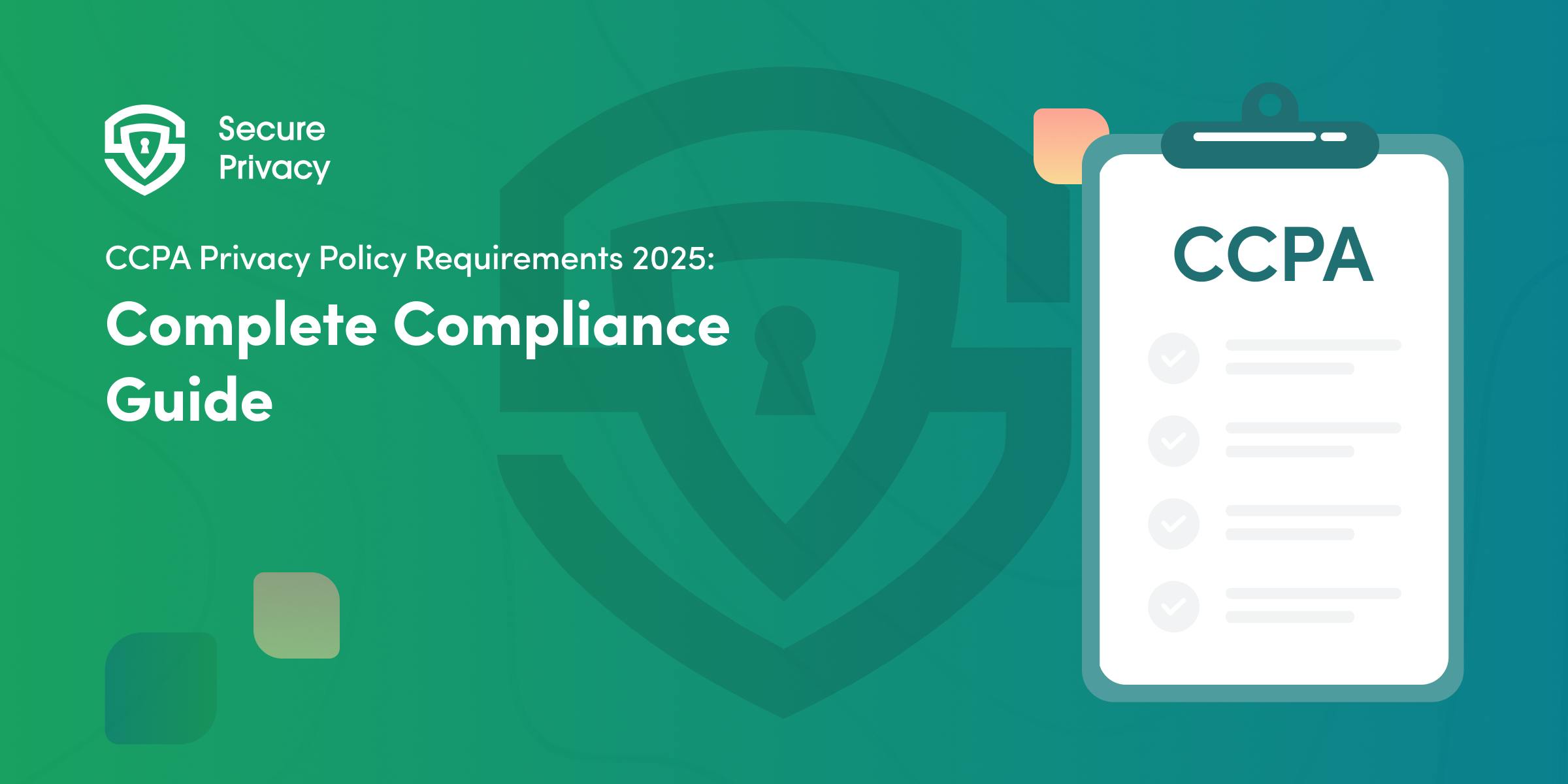CCPA Privacy Policy Requirements 2025: Complete Compliance Guide
California privacy law isn't optional anymore. With enforcement penalties reaching $7,988 per intentional violation and the California Privacy Protection Agency actively pursuing non-compliant businesses, getting your privacy policy right has become a critical legal obligation.
The CCPA privacy policy requirements 2025 have evolved significantly since the original California Consumer Privacy Act. The California Privacy Rights Act (CPRA) amendments introduced new disclosure obligations, expanded consumer rights, and stricter enforcement mechanisms that catch many businesses off guard.
This comprehensive guide breaks down exactly what your privacy policy must contain to achieve CCPA compliance in 2025, helping you avoid costly violations while building consumer trust through proper CCPA privacy policy requirements 2025 implementation.
Does the CCPA/CPRA Apply to Your Business?
Understanding CCPA applicability prevents costly compliance oversights. The law applies to businesses meeting any of these updated 2025 thresholds, making CCPA privacy policy requirements 2025 compliance essential for qualifying organizations:
Annual gross revenue exceeding $26,625,000 (increased from $25 million to reflect Consumer Price Index adjustments). This threshold captures more mid-sized businesses than the original CCPA requirements.
Processing personal information of 100,000+ California residents or households annually. This includes website visitors, customers, employees, and business contacts, making the threshold easier to reach than many businesses realize.
Deriving 50% or more of revenue from selling or sharing personal information. Under CPRA, "sharing" includes behavioral advertising and cross-site tracking, significantly expanding this category beyond traditional data brokers.
Important note: CCPA applies regardless of your business location. If you have California customers, you're subject to these requirements.
What the Law Requires: The Big Picture
CCPA demands a clear, accessible privacy notice that describes your data practices in granular detail. Unlike generic privacy policies, CCPA privacy policy requirements 2025 demand specific disclosures about data collection, usage, and consumer rights.
CPRA introduced critical new requirements including sensitive personal information protections, data retention disclosures, and enhanced consumer rights. These changes mean pre-2023 privacy policies likely violate current CCPA privacy policy requirements 2025 standards.
Transparency is non-negotiable. Vague statements like "we may collect information" no longer satisfy legal requirements. The law demands specific categories, purposes, and recipient disclosures that enable informed consumer choice.
CCPA Privacy Policy Requirements 2025: Essential Elements
Your privacy policy must include these eleven mandatory disclosures to achieve CCPA compliance and satisfy CCPA privacy policy requirements 2025 standards:
1. Categories of Personal Information Collected
List specific types of data collected in the last 12 months, organized by CCPA categories. This foundational element of CCPA privacy policy requirements 2025 includes identifiers, commercial information, internet activity, geolocation data, audio/visual information, professional information, education information, and inferences drawn from personal data.
Sensitive personal information requires separate disclosure. This includes Social Security numbers, precise geolocation, racial or ethnic origin, religious beliefs, genetic data, biometric identifiers, health information, and sexual orientation data.
2. Sources of Personal Information
Explicitly state where data originates. Common sources include direct consumer interactions, website analytics, third-party data brokers, social media platforms, marketing partners, and publicly available records as specified in CCPA privacy policy requirements 2025 guidelines.
Be specific about third-party sources. Generic statements like "business partners" don't satisfy disclosure requirements. Name categories like "advertising networks," "data analytics providers," or "social media platforms."
3. Purposes for Collection and Use
Provide detailed explanations for why you collect each data category. Examples include order fulfillment, customer service, marketing communications, fraud prevention, legal compliance, product improvement, and personalization in accordance with CCPA privacy policy requirements 2025 disclosure standards.
Link purposes to specific data types. Don't just list general business purposes. Explain why you need email addresses (communication), payment information (transaction processing), or browsing behavior (website optimization).
4. Categories of Third Parties Receiving Data
Disclose who receives personal information and for what purposes. Common recipients include service providers, advertising networks, analytics companies, payment processors, shipping partners, and professional service providers.
Distinguish between disclosures, sales, and sharing. CPRA treats these differently, with specific consumer rights applying to each category of data transfer.
5. Sale or Sharing Disclosure
Clearly state whether you sell or share personal information. Under CPRA, "sharing" includes cross-context behavioral advertising, making most websites with advertising pixels subject to this CCPA privacy policy requirements 2025 disclosure obligation.
Provide category-specific disclosures. List which categories of personal information you sell or share, to whom, and for what purposes. Include the last 12 months of activity.
6. Sensitive Personal Information Use and Disclosure
Explain how you use sensitive personal information and whether disclosure is necessary for business purposes. Consumers have the right to limit use of sensitive data beyond what's necessary for business operations.
Provide clear limitation mechanisms. If you process sensitive data, include a "Limit the Use of My Sensitive Personal Information" link alongside your "Do Not Sell" link.
7. Data Retention Periods
Specify how long you retain each category of personal information or explain how you determine retention periods. This CPRA requirement represents a critical component of CCPA privacy policy requirements 2025 that catches many businesses unprepared.
Provide category-specific timelines. Different data types may have different retention requirements based on business needs, legal obligations, or regulatory requirements.
8. Consumer Rights and Exercise Methods
Detail all CCPA consumer rights including the right to know, delete, correct, opt out of sale/sharing, limit sensitive data use, and non-discrimination protections as mandated by CCPA privacy policy requirements 2025.
Provide multiple request methods. Offer at least two methods including toll-free phone numbers, email addresses, and web portals. Online-only businesses must provide email and toll-free number options.
9. Right to Opt Out Implementation
Include prominent "Do Not Sell or Share My Personal Information" links on your homepage and privacy policy. The link must use this exact language or reasonably similar phrasing per CCPA privacy policy requirements 2025 specifications.
Honor Global Privacy Control (GPC) signals. Your systems must automatically process opt-out requests from browsers or devices sending GPC signals, treating them as valid consumer requests.
10. Non-Discrimination Statement
Explicitly state that you won't discriminate against consumers exercising their privacy rights. You cannot deny goods or services, charge different prices, or provide different service levels based on privacy choices.
Limited incentive programs are permitted. You may offer financial incentives for data collection if the incentive is reasonably related to the value of the consumer's data.
11. Policy Effective Date and Updates
Display the policy's effective date and last updated date prominently. Understanding CCPA privacy policy requirements 2025 includes knowing that CCPA requires annual policy updates and notification of material changes to consumers.
Maintain version control. Keep records of policy changes for compliance audits and consumer inquiries about previous data handling practices.
Privacy Notice Formatting and Accessibility
Homepage accessibility is mandatory. Include a clear "Privacy Policy" link in your website footer using terminology that average consumers understand. Avoid legal jargon like "Privacy Notice" or "Data Protection Policy."
Mobile optimization ensures compliance. Your privacy policy must be easily readable and navigable on smartphones and tablets, not just desktop computers.
Disability accessibility protects all consumers. Ensure screen readers can navigate your policy and that visual elements include appropriate alt text and color contrast ratios.
Multilingual policies serve diverse audiences. If your website operates in multiple languages, provide privacy policies in all supported languages to ensure equal access to privacy information.
Common CCPA Privacy Policy Mistakes in 2025
Using outdated pre-CPRA templates creates immediate compliance gaps. Many template providers haven't updated their policies to reflect current CCPA privacy policy requirements 2025, leaving businesses vulnerable to violations.
Failing to disclose behavioral advertising as "sharing" represents the most common oversight. Most websites with Google Analytics, Facebook Pixel, or similar tracking tools engage in data sharing under CPRA definitions.
Ignoring Global Privacy Control signals violates automatic opt-out requirements. Your website must technically implement GPC recognition, not just mention it in your policy.
Providing vague or generic disclosures fails to meet CCPA specificity requirements. Statements like "we collect information to improve our services" don't satisfy CCPA privadycy policy requirements 2025 categorical disclosure obligations.
Omitting data retention periods creates CPRA violations. Unlike GDPR, which allows process-based retention explanations, CCRA requires specific timeframes or clear methodology explanations.
How Secure Privacy Automates CCPA Compliance
Manual privacy policy creation and maintenance creates ongoing compliance risks as laws evolve and business practices change. Secure Privacy transforms complex legal requirements into automated protection.
Dynamic policy generation creates customized privacy policies based on your specific business model, data practices, and applicable regulations. The system updates automatically as laws change, eliminating manual monitoring requirements.
Multi-jurisdictional compliance ensures your policy addresses CCPA, GDPR, LGPD, and emerging state privacy laws simultaneously. Regional detection serves appropriate policy versions to different user locations.
Real-time business practice integration monitors your website's data collection practices and updates policy disclosures automatically when new tracking technologies or business practices are detected.
Comprehensive compliance infrastructure includes policy generation, cookie consent management, consumer request handling, and audit documentation in a unified platform designed for scalable privacy operations.
Implementation Timeline and Best Practices
Immediate assessment should review your current privacy policy against 2025 requirements. Identify gaps in categorical disclosures, consumer rights explanations, and technical implementation requirements to ensure full CCPA privacy policy requirements 2025 compliance.
Phased implementation addresses high-risk areas first including "Do Not Sell" links, GPC signal processing, and sensitive personal information disclosures. These elements face the highest enforcement scrutiny.
Staff training ensures teams understand new obligations when implementing marketing tools, analytics platforms, or customer data systems. Simple approval processes prevent accidental compliance violations.
Quarterly compliance reviews monitor policy accuracy as business practices evolve. Regular audits identify new data collection activities requiring policy updates before they create violations.
FAQ: CCPA Privacy Policy Requirements
How often must I update my CCPA privacy policy?
CCPA privacy policy requirements 2025 mandate annual updates at minimum, with immediate updates when material changes occur to data practices. Best practice involves quarterly reviews to catch changes before they become violations.
What's the difference between selling and sharing under CPRA?
Selling involves monetary consideration, while sharing includes data transfers for cross-context behavioral advertising. Most websites with advertising pixels engage in sharing, not selling.
Do I need separate policies for different states?
A comprehensive policy can address multiple state requirements simultaneously. However, different states may require different consumer request mechanisms and disclosure formats.
How specific must my data retention disclosures be?
CPRA requires specific timeframes (e.g., "3 years") or clear methodology explanations (e.g., "until account deletion plus 2 years for legal compliance"). Vague statements like "as long as necessary" don't satisfy requirements.
Can I use the same policy for CCPA and GDPR compliance?
Yes, but the policy must address both laws' specific requirements. GDPR emphasizes lawful basis while CCPA focuses on categorical disclosures and consumer rights. Comprehensive policies can satisfy both.
What happens if I don't comply with CCPA privacy policy requirements?
Non-compliance with CCPA privacy policy requirements 2025 results in penalties reaching $7,988 per intentional violation, with additional civil lawsuit exposure under California's private right of action. The California Privacy Protection Agency actively investigates violations across industries.
Get Started For Free with the
#1 Cookie Consent Platform.
No credit card required
Best Consent Management Platforms in 2025: Feature-by-Feature Comparison
Privacy enforcement has intensified dramatically in 2025, with regulators issuing record fines and consumers demanding transparent data practices. The best consent management platforms 2025 offer more than basic cookie banners—they provide comprehensive privacy automation, real-time compliance monitoring, and seamless user experiences across global regulations.

How Agencies Can Offer Privacy-as-a-Service
Your clients are drowning in privacy compliance requirements, and you're missing out on a $2 billion revenue opportunity. Privacy-as-a-Service is transforming how digital agencies generate recurring revenue while solving their clients' most pressing legal challenges.
- Legal & News
- Data Protection

CCPA Privacy Policy Requirements 2025: Complete Compliance Guide
California privacy law isn't optional anymore. With enforcement penalties reaching $7,988 per intentional violation and the California Privacy Protection Agency actively pursuing non-compliant businesses, getting your privacy policy right has become a critical legal obligation.
- Legal & News
- Data Protection

